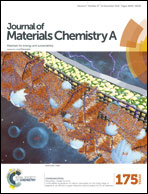Hollow α-Fe2O3 nanofibres for solar water oxidation: improving the photoelectrochemical performance by formation of α-Fe2O3/ITO-composite photoanodes†
Abstract
We demonstrate the synthesis and photoelectrochemical performance of high-aspect ratio dense and hollow α-Fe2O3 nanofibres, and the formation of core–shell-like α-Fe2O3/indium-tin oxide (ITO) nanocomposites utilised as a photoanode for solar water splitting. α-Fe2O3 nanofibres were prepared via a single-nozzle electrospinning technique using iron chloride (FeCl3) and poly(vinylpyrrolidone) (PVP) as precursors, followed by calcination. A new synthetic formation mechanism has been proposed taking into account the significance of three control parameters: (i) the iron precursor, (ii) the role of a co-solvent and (iii) the influence of the humidity on the tube evolution of α-Fe2O3 nanotubes. Hollow α-Fe2O3 fibres showed enhanced photocurrents and incident photon-to-current efficiency (IPCE) values compared to dense fibres, which are ascribed to the superior surface area of hollow fibres offering a good accessibility for the electrolyte and thus leading to improved mass transport. The photoelectrochemical properties of the α-Fe2O3 nanofibres could be further enhanced by the combination with highly crystalline, uniform ITO nanocrystals (Ø 10 nm), thus forming a core–shell-like α-Fe2O3/ITO fibre nanocomposite. The doubled photocurrent of the α-Fe2O3/ITO nanocomposite can most likely be attributed to the fast interfacial charge carrier exchange between the highly conductive ITO nanoparticles and α-Fe2O3, thus inhibiting the recombination of the electron–hole pairs in the semiconductor by spatial separation.


 Please wait while we load your content...
Please wait while we load your content...